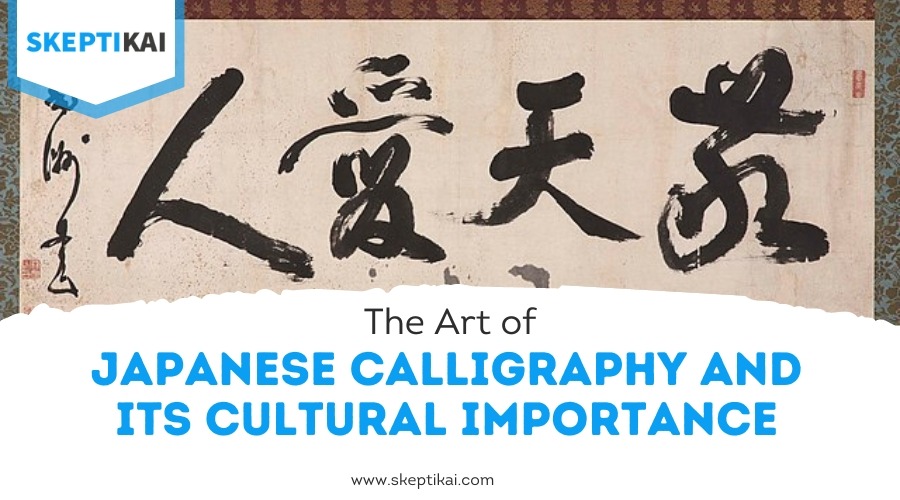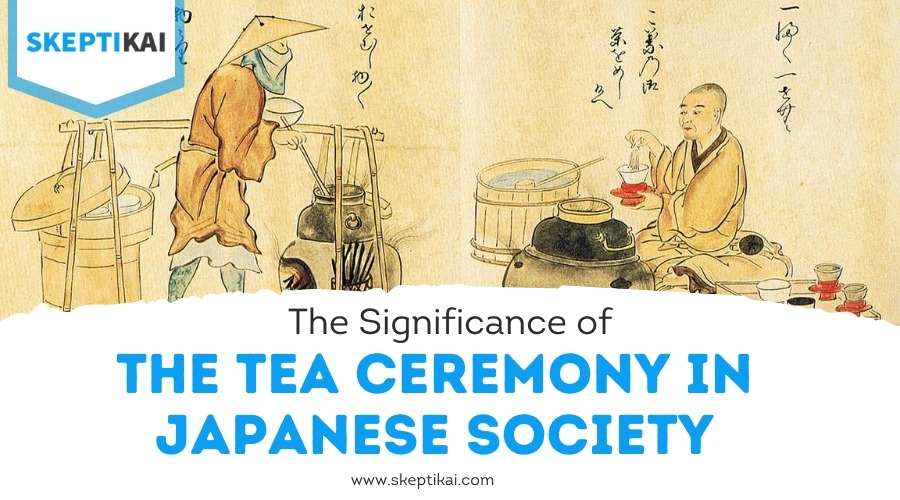How Did Portuguese Influence Japanese Society and Culture?
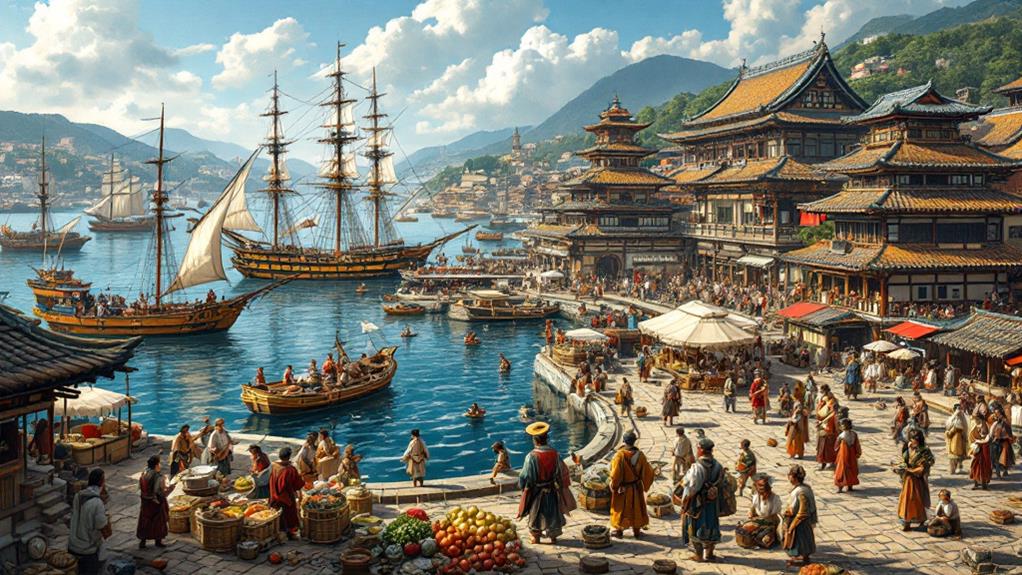
You'll find that the Portuguese had a profound impact on Japanese society and culture from the mid-16th century onwards. They introduced firearms like the arquebus, transforming military tactics. Portuguese missionaries brought Christianity, creating a blend of beliefs and cultural syncretism. You'll also notice their influence on the Japanese language through loanwords like "pan" (bread). In the culinary domain, they introduced tempura, integrating their culinary techniques into Japanese cuisine. They altered trade practices and contributed to artistic and ecclesiastical exchanges. This cross-cultural interaction laid the groundwork for modern aspects of Japanese life and customs, which you'll soon uncover.
Arrival of the Portuguese
In the mid-16th century, a few adventurous Portuguese traders and missionaries made their way to Japan, marking the beginning of a significant cultural exchange. You'd find these Portuguese adventurers initiating this expedition with curiosity and intent to trade. Their arrival was made possible by their advanced maritime technology, which set them apart from other seafaring nations. These explorers used their navigational skills and knowledge of the sea to reach Japan, a land previously unknown to Europeans. This period of exchange paved the way for Westernization in Japan, as traditional customs began to face challenges due to new influences. As you investigate this period, you'll notice how the Portuguese brought with them not just goods, but also new ideas and techniques that would soon influence Japanese society. Their ships, laden with novelties like firearms, textiles, and new foods, became the conduits for this exchange. The Japanese were particularly fascinated by the Portuguese maritime technology, which introduced them to new shipbuilding techniques and navigational tools. This knowledge would eventually improve Japan's own maritime capabilities.
Introduction of Christianity

Keen to spread their faith, Portuguese missionaries didn't waste time in introducing Christianity to Japan following their initial arrival. You'd find these missionaries, like St. Francis Xavier, initiating missionary efforts with great zeal. They sought to convert the Japanese people, establishing churches and schools in different regions. The missionaries aimed to integrate Christian beliefs with the local culture, promoting a form of cultural syncretism. They didn't just teach religion; they engaged with the Japanese on multiple levels, learning the language and customs to better communicate their message. Notably, this cultural exchange echoes the way geishas have historically preserved and promoted traditional Japanese arts amidst societal changes. Initially, many Japanese were intrigued by Christianity, as it offered new perspectives and values. You'd see daimyo, or regional lords, welcoming the missionaries, seeing potential political and economic benefits from aligning with the Portuguese. These conversions, however, weren't always purely spiritual; some Japanese sought to strengthen trade ties with the Portuguese.
Despite the growing influence of Christianity, it faced resistance from some Japanese authorities who viewed it as a threat to traditional beliefs and social order. Over time, this led to a complex relationship between the missionaries and Japanese society, ultimately resulting in periods of persecution and suppression. Yet, the seeds of cultural exchange had already been sown.
Impact on Japanese Language

Embracing the exchange with the Portuguese, the Japanese language absorbed several Portuguese words, marking a significant linguistic impact. This exchange resulted in numerous loanwords becoming part of everyday vocabulary. You'll find terms like "pan" (bread) and "botan" (button) rooted in Portuguese origins, showcasing how deeply intertwined these languages became. The phonetic influence of Portuguese reshaped Japanese pronunciation and introduced new sounds to adapt to foreign words.
Incorporating these loanwords necessitated a linguistic adaptation within the Japanese language structure. It wasn't just about adding new vocabulary; it involved altering cultural expressions and idiomatic phrases to reflect foreign concepts. This adaptation also extended to social interactions, where new terms facilitated communication between Japanese and Portuguese speakers.
Moreover, the influence of Portuguese on Japanese written scripts can't be overlooked. As these loanwords were integrated, they required new kanji or kana representations, changing the way words were visually depicted. These written adaptations helped preserve the phonetic nuances of Portuguese while fitting seamlessly into Japanese writing. Through this rich linguistic exchange, you can see how the Portuguese left a lasting imprint on Japanese language, enriching its diversity and cultural depth.
Adoption of Firearms
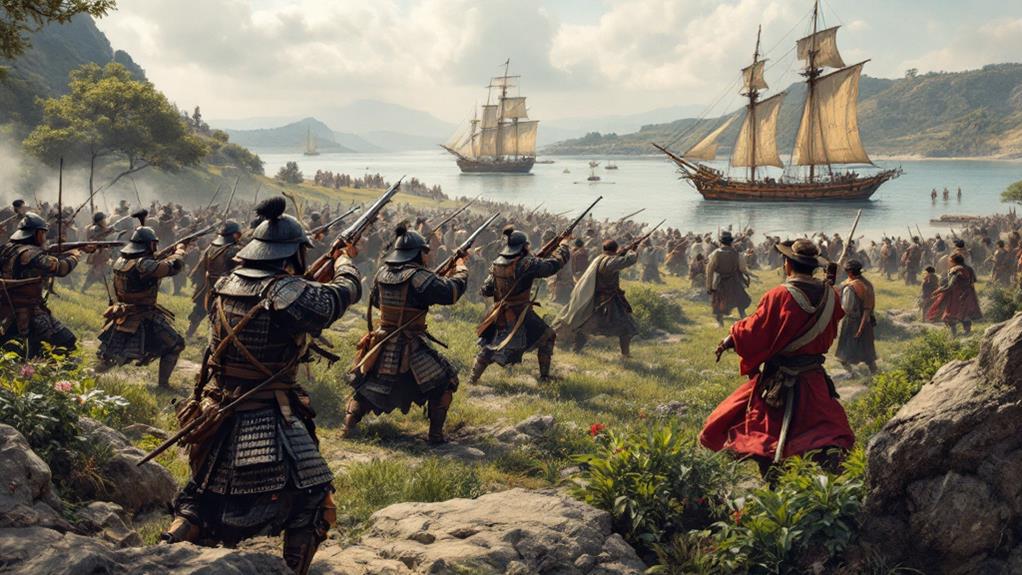
Portugal's arrival in Japan heralded a transformative period in Japanese warfare with the adoption of firearms. Imagine you're in the 16th century, and the Portuguese have just introduced the arquebus, a type of matchlock gun, to Japanese shores. This new weapon quickly captured the attention of samurai and daimyo, keen to gain an edge in battle. You'd see a shift in military tactics as traditional samurai swordsmanship began to share the battlefield with gunpowder weaponry.
Once the Japanese realized the potential of firearms, they didn't just stop at using imported pieces. They took to weapon manufacturing with remarkable enthusiasm and skill. You'd witness the rapid establishment of workshops dedicated to producing these matchlock guns, known locally as "tanegashima," named after the island where the Portuguese initially landed. These workshops didn't just replicate the European models but improved upon them, integrating local craftsmanship and materials to make them more efficient and reliable.
The widespread production and strategic use of firearms led to significant changes in military tactics. Armies started employing volley fire techniques, forever altering the landscape of Japanese warfare. This adoption of firearms marked a crucial moment in Japan's military history.
Influence on Japanese Cuisine
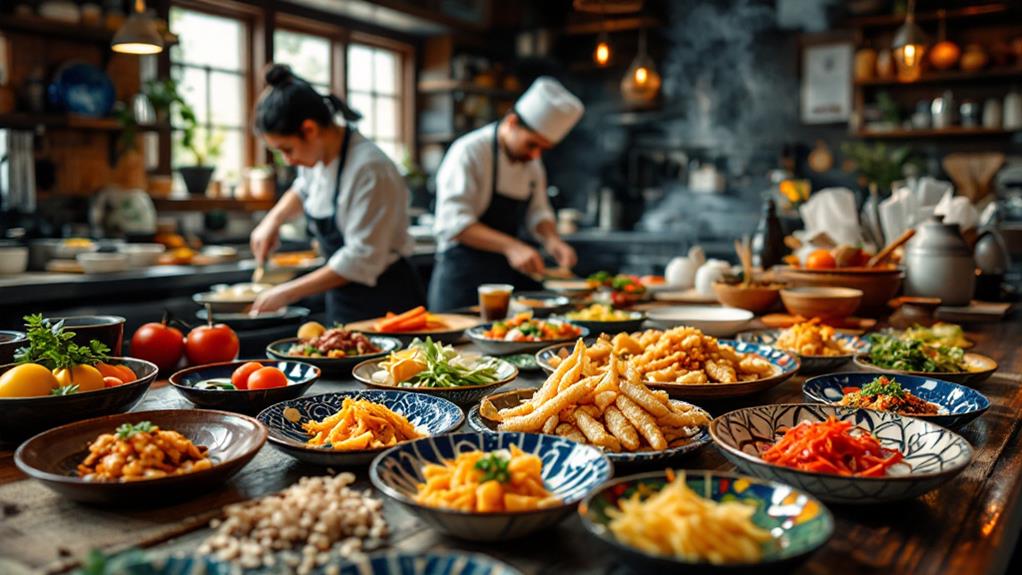
From the moment the Portuguese set foot in Japan, they left an indelible mark on the local cuisine. One of the most notable contributions was the introduction of tempura. You may be surprised to know that the origins of tempura are deeply rooted in Portuguese culinary traditions. The technique of batter-frying food was introduced by the Portuguese in the 16th century, and the word "tempura" itself is believed to derive from the Latin "ad tempora quadragesimae," which refers to the Lenten period when eating meat was prohibited, leading to the frying of vegetables and seafood.
Besides tempura, the Portuguese also introduced sweet potatoes to Japan. These became a crucial part of the Japanese diet, especially in the regions where rice cultivation was challenging. The sweet potato's adaptability and nutritional value made it a staple in Japanese households, influencing numerous traditional dishes over time. By adopting these new ingredients and cooking methods, Japanese cuisine evolved remarkably, blending foreign influences with local traditions to create something distinctly Japanese. You can still taste this fusion today in the flavors and techniques that have become integral to Japan's rich culinary tapestry.
Changes in Trade Practices
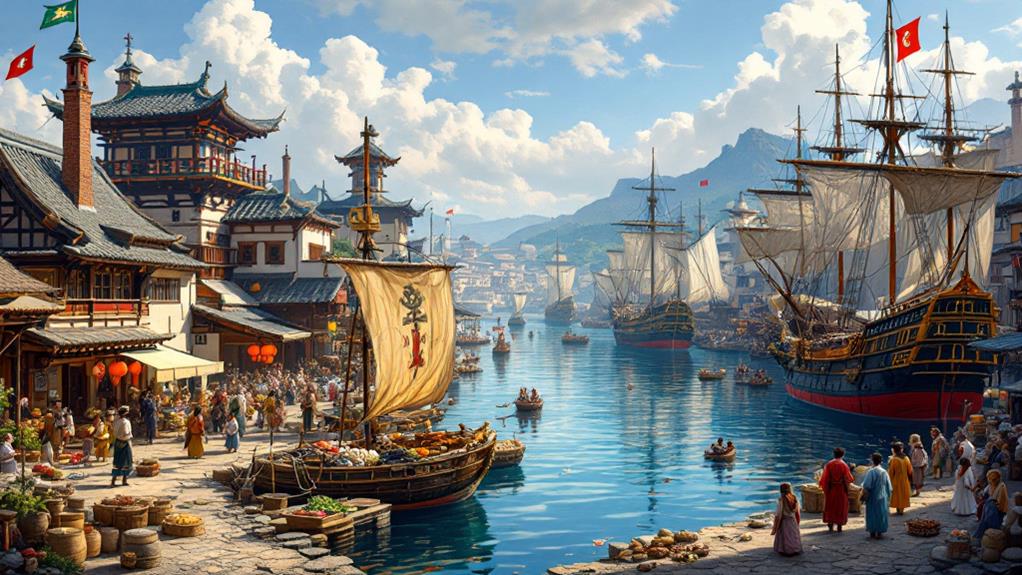
The arrival of the Portuguese in Japan in the 16th century sparked significant changes in trade practices that would shape the country's economic landscape. As you investigate this timeframe, you'll notice how maritime trade flourished, opening new avenues for economic exchange. The Portuguese introduced Japan to a broader global trading network by directly connecting it with Europe, China, and other Southeast Asian countries. This connection wasn't just about goods—ideas and innovations flowed along these maritime routes too.
You're likely aware that the Portuguese brought firearms, textiles, and other goods, which were highly sought after by the Japanese. This led to the establishment of Nagasaki as a major port, crucial for both import and export activities. The Portuguese weren't just traders; they were catalysts in transforming how the Japanese conducted business. They emphasized negotiation, contracts, and partnerships, which were less common in prior Japanese trade practices.
As you explore further, you'll see how these changes influenced the Japanese economy, encouraging local merchants to adopt new methods and expand their horizons. This time marked a shift from isolated trade to a more interconnected system, laying the groundwork for future economic developments.
Cultural and Artistic Exchange
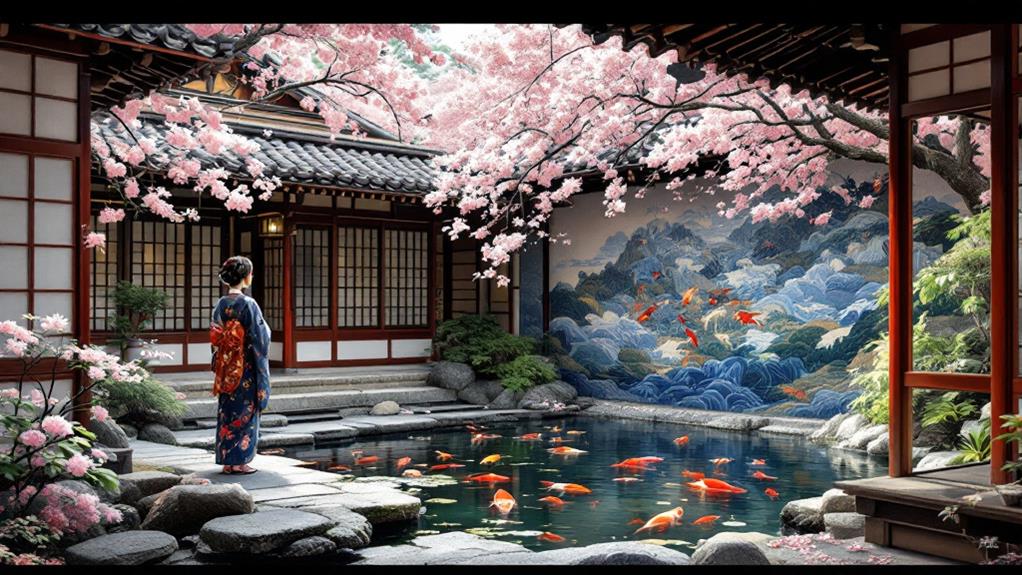
Amidst the lively trade activities of the 16th century, the Portuguese didn't just bring goods to Japan—they also introduced a rich tapestry of cultural and artistic influences. These interactions sparked a fusion of styles and techniques that left a lasting mark on Japanese art and craftsmanship. For instance, the Portuguese introduced advanced ceramic techniques to the Japanese artisans. You'd find that these new methods, which included glazing and firing innovations, allowed for more durable and aesthetically pleasing pottery. This infusion of knowledge enhanced Japanese ceramics, leading to the creation of exquisite pieces sought after by collectors worldwide.
Textile patterns also underwent a transformation due to Portuguese influence. You might notice that the colorful and intricate designs inspired by Portuguese textiles began to appear in Japanese garments and fabrics. The bold motifs and color combinations introduced by the Portuguese were integrated into traditional Japanese clothing, adding a fresh dimension to the existing styles. This cross-cultural exchange enriched Japan's artistic landscape, blending foreign elements with local traditions. As you investigate this period, you'll see how these artistic influences became a crucial part of Japan's cultural evolution, showcasing a unique blend of East and West.
Legacy in Modern Japan
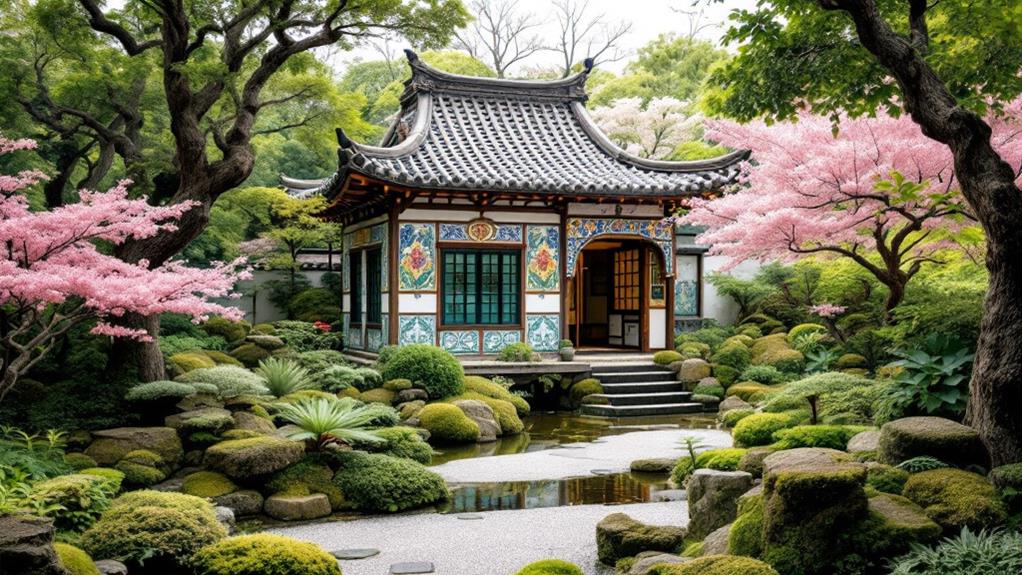
Portugal's centuries-old influence in Japan still echoes today, subtly woven into the fabric of modern society. When you walk through certain Japanese cities, you might notice the architectural styles that hint at this historical connection. Influences from Portuguese design can be seen in some of Japan's older structures, especially in port cities like Nagasaki, where Western elements blend with traditional Japanese aesthetics. These architectural styles reflect a time when Portugal played a significant role in opening Japan to the wider world.
In addition to architecture, Portuguese influence is evident in some social customs. For instance, Japan's adoption of tempura came from Portuguese missionaries and traders in the 16th century. This beloved dish shows how culinary exchanges have left a lasting impact on Japanese cuisine. Likewise, the Japanese language has borrowed words from Portuguese, such as "pan" (bread), showcasing the depth of cultural integration.
You can also see this legacy in Japan's openness to blending foreign elements with its own traditions. By understanding these influences, you appreciate how Portugal's presence contributed to shaping Japan's unique cultural tapestry, enriching its heritage and leaving a lasting legacy in modern society.

